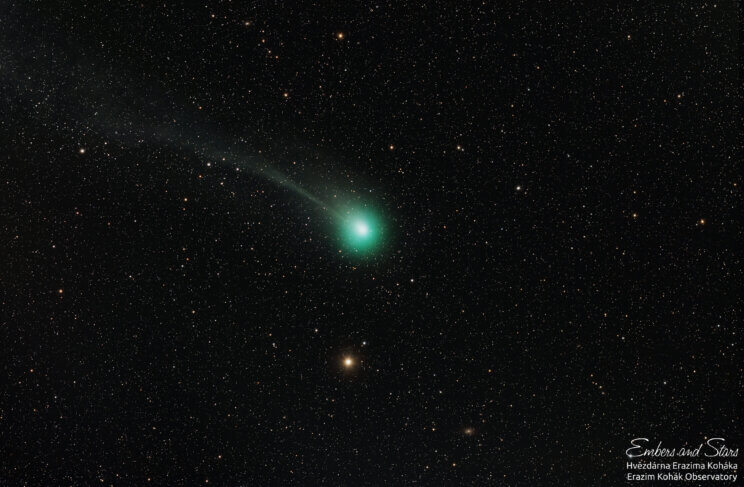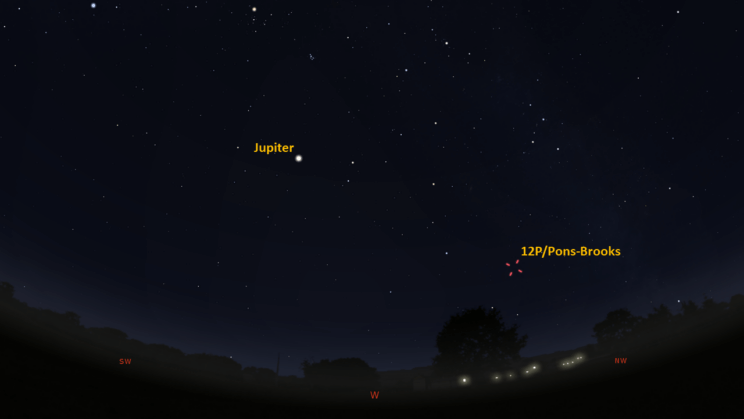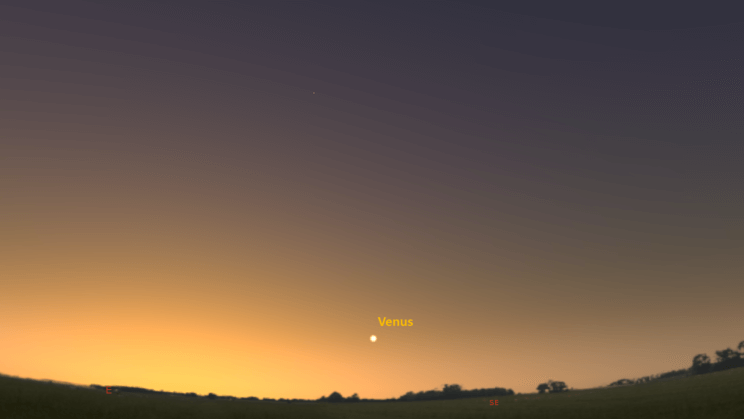This is the Saint Louis Science Center’s NIGHT SKY UPDATE for the week of Saturday, February 24, 2024.
Information updated weekly or as needed.
Times given as local St. Louis time which is Central Standard Time (CST). For definitions of terminology used in the night sky update, click the highlighted text. If relying on times posted in Universal Time (UT), St. louis is -6 hours when CST.
Join us for our next star party, Friday, March 1, 2024, held in association with the St. Louis Astronomical Society. For details, see the information at the bottom of this page or visit https://www.slsc.org/explore/mcdonnell-planetarium/public-telescope-viewings/
Observing Highlight of the Week

Comet 12P/Pons-Brooks seen on February 12, 2024. In this image you can see the greenish colored coma of the comet and its ion tail interacting with the solar wind. Image credit: Jan Beránek.
The highlight for this week will be one of two comets that could be great targets for us this year. The comet that will likely be best is C/2023 A3 Tsuchinshan-ATLAS which is expected to be an easy target later this year in October. The comet that is already visible is the periodic comet 12P/Pons Brooks.
Comet 12P/Pons-Brooks will be best in April as it reaches perihelion on April 21, 2024. Throughout the month of April, the comet will increase in magnitude reaching a peak brightness of 5th magnitude. As of February 24, 2024, 12P/Pons-Brooks is at 7.5 magnitude. This puts it within reach of some binoculars; however, city lights will likely interfere making it a telescope target.
While the best views of comet 12P/Pons-Brooks are still over a month away, now is the time to prepare for what should be a good binocular target. If you have them, grab binoculars every clear night until April and try to spot the comet after sunset. Start to familiarize yourself with the star fields it will pass through. Currently, 12P/Pons-Brooks is found in Andromeda. As we head through March and April, the comet will pass through the constellations Pisces, Triangulum, Aries and Taurus. I recommend using a star atlas that shows stars down to 7.5 or 8 magnitudes. If you don’t have something like this, you can rely on planetarium software such as Stellarium. This is a free software that is available for all platforms.
As of this week you should look for the comet around 7:00 p.m. in the northwestern sky about 18° above the horizon. The comet will still be high enough to see by 9:00 p.m. however the full moon will interfere with what we see. If you have trouble finding the comet this week wait a week or so until we are closer to new moon. New moon occurs on March 10, 2024. Be aware that as we head into March and April, 12P/Pons-Brooks will be seen lower to the horizon each night. So, every night you attempt to spot the comet, make sure you know when the Sun will set.
Lastly, people have started to realize that 12P/Pons-Brooks could be visible during the total solar eclipse on April 8, 2024. As it will be near perihelion, the comet should appear in the darker portion of sky during totality. The comet will be found 6° west of Jupiter and should be visible using binoculars. There is a possibility that the comet could become a naked eye target if it exhibits an outburst event the comet has become known for. At the end of 2023, 12P/Pons-Brooks was exhibiting a periodic behavior of increasing in magnitude then dimming. Scientists believe this was caused by cryovolcanic activity. As the location of this activity rotates to an Earth facing direction, the comet would increase in magnitude if the cryovolcanic vent was active. If this were to occur on April 8, it is possible the comet’s magnitude could increase to naked eye visibility. While there is no way to know for sure, it remains an intriguing possibility. If you plan to use binoculars to spot the comet during totality, it is imperative that you are sure of the start and end times of totality. Looking for the comet outside of totality will be very dangerous as the Sun will not be fully obscured by the Moon. Pointing unfiltered binoculars at even a sliver of exposed Sun will damage your eyes so be very careful.
The Sun and Moon

The Moon as seen from the International Space Station, on July 31, 2011.
Credit: NASA
Sun
Sunrise is at 6:40 a.m. on Saturday, February 24 and sunset is at 5:48 p.m. providing us with roughly 11 hours of daylight this week. Even after sunset, light from the Sun will dimly illuminate our sky for about 1 hour and 30 minutes. This period is called twilight, which ends around 7:17 p.m. this week. For those with a sundial, local noon occurs around 12:14 p.m. this week.
| Day | Sunrise | Sunset | ||||||||||
|---|---|---|---|---|---|---|---|---|---|---|---|---|
| 24-Feb | 6:40 a.m. | 5:48 p.m. | ||||||||||
| 25-Feb | 6:39 a.m. | 5:49 p.m. | ||||||||||
| 26-Feb | 6:38 a.m. | 5:50 p.m. | ||||||||||
| 27-Feb | 6:36 a.m. | 5:51 p.m. | ||||||||||
| 28-Feb | 6:35 a.m. | 5:52 p.m. | ||||||||||
| 29-Feb | 6:33 a.m. | 5:53 p.m. | ||||||||||
| 1-Mar | 6:32 a.m. | 5:54 p.m. | ||||||||||
| 2-Mar | 6:31 a.m. | 5:55 p.m. | ||||||||||
| 3-Mar | 6:29 a.m. | 5:56 p.m. |
Moon
Moonrise for Saturday, February 24 is at 6:06 p.m. and moonset occurred at 7:23 a.m. on the following day. On Saturday, February 24, the Moon will exhibit its full phase with roughly 100% disk illumination. By the end of the week the Moon will exhibit a waning crescent phase with 46% disk illumination. Last quarter moon occurs on March 3, 2024, at 9:24 a.m.
International Space Station (ISS) Observing

There are several visible passes of ISS from St. Louis for the week of February 24. They occur during morning hours. The table below lists the best of these passes that will be seen from St. Louis. If you do not live in the area, you can use https://heavens-above.com/ to set your viewing location and get times for where you are.
Catch ISS from St. Louis starting Saturday, February 24, 2024
| Date | Starts | Max. altitude | Ends | |||||||
|---|---|---|---|---|---|---|---|---|---|---|
| Time | Alt. | Az. | Time | Alt. | Az. | Time | Alt. | Az. | ||
| 02 Mar | -1.3 | 5:21:00 | 10 | NNW | 5:23:20 | 17 | NNE | 5:25:41 | 10 | ENE |
| 03 Mar | -1.1 | 4:34:24 | 13 | N | 4:35:06 | 13 | NNE | 4:36:52 | 10 | NE |
Magnitude (Mag): The Measure of brightness for a celestial object. The lower the value is, the brighter the object will be.
Altitude (Alt): The angle of a celestial object measured upwards from the observer’s horizon.
Azimuth (Az): The direction of a celestial object, measured clockwise from an observer’s location with north being 0°, east being 90°, south being 180° and west being 270°.
Detailed information regarding all unmanned exploration of our universe, missions past, present, and planned, can be found at Jet Propulsion Laboratories:
The Visible Planets

Looking west at 7:00 p.m. on February 24, 2024. Credit: Stellarium, EG

Looking southeast at 6:20 a.m. on February 25, 2024. Credit: Stellarium, EG
This week, only one naked eye planet is easily seen. Jupiter is visible in the south once it is dark. Venus can be found in the southeast before sunrise, but trees will be an issue for most.
Venus
Venus rises this week around 5:35 a.m. Venus is becoming increasingly difficult to spot due to its low altitude. Venus is approaching superior conjunction on June 4, 2024. Each day we get closer to this date, Venus will appear nearer the Sun. This week, your best chance to see Venus comes about 20 minutes before sunrise. Be careful if you look for Venus this week as the Sun rises soon after Venus is high enough to see. Unfortunately, for the remainder of Venus’s apparition, the ecliptic remains at a low angle to the horizon. For many this means Venus may already be lost from view.
Jupiter
Jupiter is now the only planet easily seen during evening hours. You can find Jupiter about 30 minutes after sunset, high in the southwestern sky. Jupiter sets around 11:01 p.m. this week.
Our next Star Party will be held on Friday, March 1, 2024, from dusk until 9 p.m.
As part of the Saint Louis Science Center’s First Fridays, weather permitting, the St. Louis Astronomical Society and the Science Center will set up a number of telescopes outdoors and be on-hand to answer your questions. Telescope viewing begins once it is dark. Regardless of the weather on March 1, join us indoors in our planetarium theater for “The Sky Tonight”. Showtime is at 7 p.m. This free, indoor star program will introduce you to the current night sky. Doors open 15 minutes before show time. Shows begins at 7 p.m. Sorry, no late admissions due to safety issues in the darkened theater.
The St. Louis Astronomical Society helps host the monthly Star Parties at the Saint Louis Science Center which are held on the first Friday of each month. Our Monthly Star Parties are open to the public and free of charge.
James S. McDonnell Planetarium
Night Sky Update: February 24-March 3, 2024






